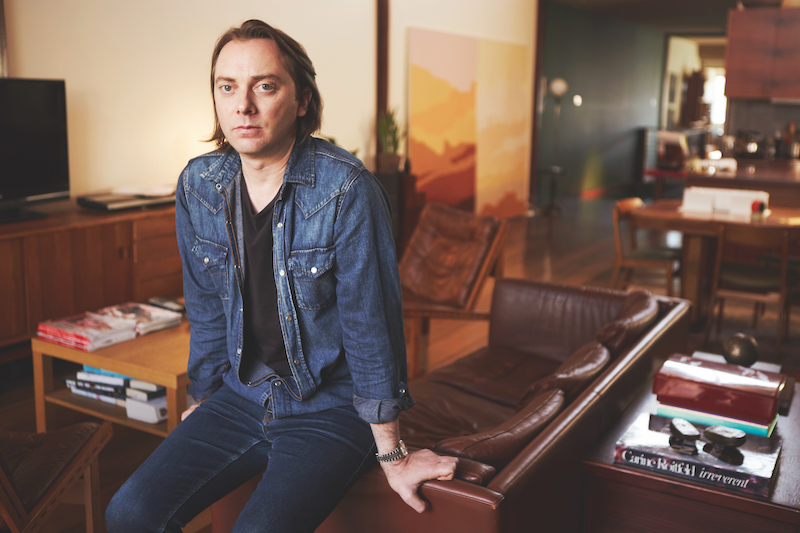Darren Sylvester
Coated in a glossy sheen and infused with pop culture references, Darren Sylvester’s latest work straddles the boundary between high art and fashion editorial.
Words: Gina Fairley
Photography: Zan Wimberley
Darren Sylvester could be described as the poster boy for Generation Y; his ability to flick and filter, to snare associations and to elevate aspiration comes from an astute familiarity with advertising that pits high production against high reality. His practice over the last twenty years has moved indiscriminately between photography, video, sculpture and music, consistently global in its reach and yet freeze-framed to the moment that produced it. He throws popular culture into the mosh pit where collisions can be casual or contrived, not unlike swiping through tabs of an Internet browser.
For Broken Model (Sullivan + Strumpf), Sylvester again returns to film and fashion world tropes. Over a tonne of sand surfaces a 13-meter catwalk that navigates viewers through the gallery space. There is no arrival, no magic endpoint or Nirvana. It is about the pantomime of presentation, and its promise, like most advertising, is fabricated.
The sand has been industrially coloured a saccharine purple reminiscent of grape bubble gum. You can almost smell its vibrancy. There is a slight sparkle to its crystalline granules, which play off glittering green faces of models that backdrop the installation – a faux-magazine cover punched to steroid proportions.
Scattered along the catwalk in perfect narrative are coconuts cast in bronze and porcelain. One could be mistaken to have stepped on-set of a Bounty chocolate advertisement or film. Castaway meets Prêt-a-porter? The wallop is fittingly seductive and yet its amplified pop edge digs deeper than the surface that it appears to dwell.
Like most of Sylvester’s work its genesis is a spark. For Broken Model that was the splice of a shipwrecked Tom Hanks in the 2000 film Castaway attempting to open a coconut, with a faceless model encountered while trawling his iPad, who had fallen on a runway; a flotilla of models around her disengaged.
Sylvester explains that Hanks lost weight for a year to make the role convincing. And while supposedly deserted, he was really in Fiji, the land of designer coconut water. And the model? That was Coco Rocha, and the fall had been staged for Valentino’s farewell show. Does reality lessen their impact?
Sylvester’s work first came to prominence with highly staged photographic portraits in the late 1990s. That remit again sets anchor in this new installation but, boldly, the images have been blown up to billboard proportions.
Sylvester’s departure to digital with his last exhibition Dreams End With You (Sullivan + Strumpf, 2014) has been reversed. Shot on 4×5 transparencies these new works are highly directed, highly scripted images. He’s used a grid structure to push the photographs more than 3-metres, which magnifies the psycho-fissures of alienation inherent to Broken Model and Green (2016).
This mature work of Sylvester has become more agile, and driven by an image’s ability to manipulate and confuse, and the tensions created are very powerful. That is played out correspondingly in the coconut sculptures that, unlike Hanks idyllic fabrication of bounty, were purchased by Sylvester from the local supermarket. The ultimate readymade subsequently cast.
They sit on display just as a Prada handbag might in-store, cognisant of their powers of visual merchandising and occupying a space between the illusive, the over advertised, and plain fact.
Sylvester expanded his oeuvre from photography to objects in 2007 when he made a series of wooden masks that resembled anti-ageing facemasks. Later in 2012 it was a suite of bronze masks that took their cue from Stanley Kubrick’s film Eyes Wide Shut (1999). Polished only on one side, illusion and material reality coexisted.
This is the place where Sylvester’s work dwells so eruditely today, that serving-up of a holistic product philosophy and its flipside questioning. In Sylvester’s hands, it punches outside the streams of consumerism into high art and with its elevation universal truths are arrived upon.
Darren Sylvester’s work is held in public collections including the Queensland Art Gallery, Art Gallery of Western Australia, National Gallery of Australia, Art Gallery of NSW and Artbank.
This article was originally published in Art Collector issue 77, JUL–SEPT 2016.









